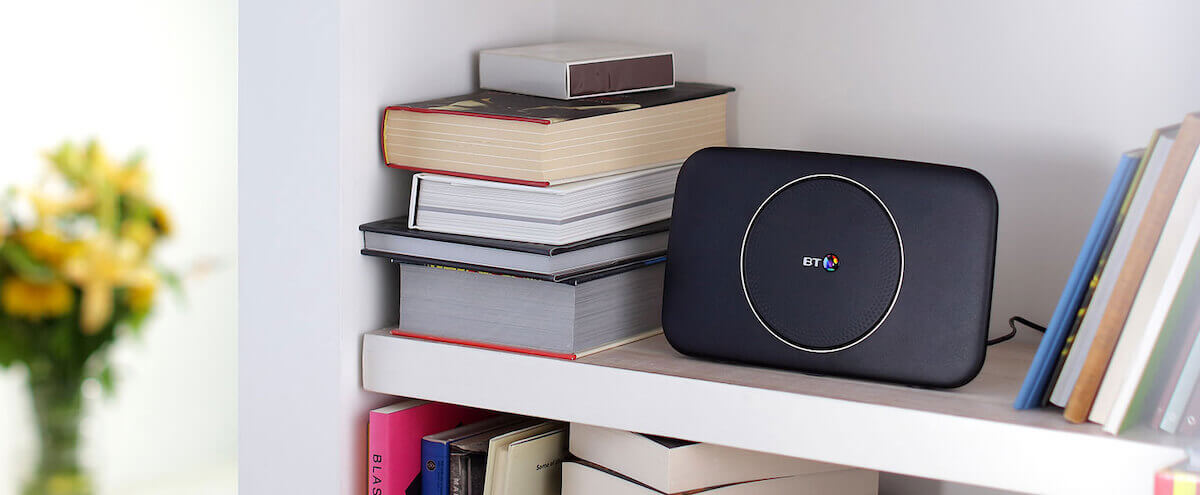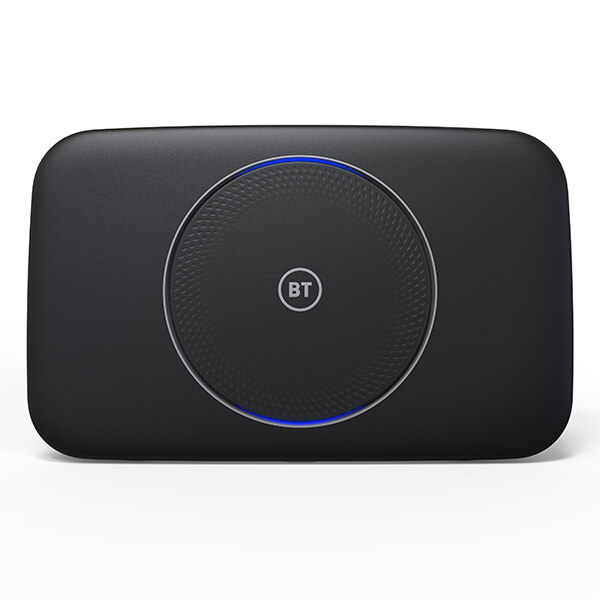Phil Wilkinson-Jones | October 27th, 2021
BT Smart Hub routers
BT is the UK’s biggest broadband provider and, like other providers, will give you a free router if you sign up to one of its broadband deals. BT has a few routers – the Smart Hub 2 is the newest – and is up there with the very best routers offered by broadband providers.

This is something that shouldn’t be overlooked when searching for a new broadband deal. Your router is the device that connects you to the wider world and the gatekeeper that stops outside threats from getting into your home network. So what makes BT’s routers so great? And how do you get one set up in your home? Fear not, that’s why we’re here.
How to get a BT broadband router
There are two ways to get hold of a BT router. You get a router free with any BT broadband deal, although the router you get depends on the deal you choose. You can also buy a router outright from BT – this is primarily an offer aimed at BT customers on legacy packages who may not qualify to get one of the new routers for free, but the Hubs do work with some other providers (we’re thinking specifically of the BT-owned Plusnet here and maybe some of the other smaller providers: BT routers definitely won’t work with Virgin Media, Sky or TalkTalk). If you’re thinking of replacing your old free router, take a look at our guide to using your own router for broadband.
At the time of writing, BT’s entry-level standard broadband package comes with a BT Home Hub 4. This router is a few years old now but will easily give you the modest speeds promised by an ADSL package. Go up to BT’s standard fibre broadband package, Fibre Essential, and you get the BT Smart Hub 2; this is also the case with Fibre 1 and Fibre 2. The biggest difference between these packages is what speeds you can expect.
To improve your home internet set-up, you might want to sign up for BT Halo. The latest version, Halo 3+, guarantees you a reliable internet service by providing you with an EE mini router, known as Hybrid Connect, which will boot up if your cabled connection goes down along with Complete Wi-Fi discs that ensure your wifi reaches every room in your home. It also comes with a price promise that your bill won’t go up when your contract ends and double data allowances for anyone who also has a BT Mobile SIM.
Note that customers can choose to sign up for Complete Wi-Fi and Hybrid Connect individually however, which works out much cheaper.
In most cases, you can expect your new BT router to arrive in the post within a couple of weeks of signing up to a new BT package or of upgrading to Halo if you’re an existing BT customer. An engineer is usually dispatched to connect you after about 14 days, too, but this can sometimes take longer.
-
 £50 Bill CreditM125 Fibre Broadband
£50 Bill CreditM125 Fibre Broadband- 132Mb average speed +
- Unlimited usage +
- No phone line
- £50 Bill Credit
- No 2024 Price Rise
£26.50 per month(prices may change during contract)£50 Bill Credit£0 one-off cost18 month contract -
 £70 Gift CardUltrafast Plus
£70 Gift CardUltrafast Plus- 500Mb average speed +
- Unlimited usage +
- PAYG calls
- £70 Gift Card
£33.00 per month(prices may change during contract)£70 Gift Card£5 one-off cost24 month contract -
 £65 Gift CardSuperfast
£65 Gift CardSuperfast- 61Mb average speed +
- Unlimited usage +
- PAYG calls
- £65 Gift Card
£27.00 per month(prices may change during contract)£65 Gift Card£5 one-off cost24 month contract
BT Smart Hub 2 features
Not all routers are the same. Many of us leave them untouched in the corner of the room once they’re up and running, but there are a number of features worth paying attention to, which we’ll go through now. You might also want to take a look at this guide to broadband router settings.
As there are a number of BT routers on the market, we’re going to focus here on the most recent release – the Smart Hub 2 – and we’ll get onto BT’s older routers a bit later on.

Smart Hub 2
- Next generation Wi-Fi – The Smart Hub uses the latest wireless standard (802.11ac) to deliver the fastest Wi-Fi speeds possible
- Smart channel selection – The Smart Hub automatically connects your devices to the fastest Wi-Fi channel and frequency available
- Smart scan – The router continually checks your network connection as well as its own performance and automatically reboots if there’s a problem
- Dual band – Like many modern routers, the Smart Hub uses both the 2.4GHz and 5GHz bands
- Four gigabit Ethernet ports – The Smart Hub has four gigabit Ethernet ports, so you can use a wired connection for up to four devices
- Seven antennae – The Hub has seven aerials, which is more than previous BT routers
- LEDs can be switched off – The little things matter, and not all of us want a display of blue lights constantly flashing in the corner of the room
- DECT phone compatible – The Smart Hub 2 supports Digital Enhanced Cordless Telecommunications (DECT), a new digital standard for landline phones
- Complete Wi-Fi – BT Complete Wi-Fi uses one or more discs to give you better Wi-Fi coverage throughout your home
If there are any unfamiliar terms you’d like a more in-depth explanation of, check out our jargon-busting guide.
-
 £50 Reward CardFibre 2
£50 Reward CardFibre 2- 67Mb average speed +
- Unlimited usage +
- No phone line
- £50 Virtual Reward Card
£36.99 per month(increases on the 31st March 2025 by CPI +3.9%)£50 Reward Card£31.99 one-off cost24 month contract -
 £50 Reward CardFull Fibre 100
£50 Reward CardFull Fibre 100- 150Mb average speed +
- Unlimited usage +
- No phone line
- £50 Virtual Reward Card
£29.99 per month(usually £30.99)(increases on the 31st March 2025 by CPI +3.9%)£50 Reward Card£31.99 one-off cost24 month contract -
 £50 Reward CardFull Fibre 900
£50 Reward CardFull Fibre 900- 900Mb average speed +
- Unlimited usage +
- No phone line
- £50 Virtual Reward Card
£44.99 per month(usually £59.99)(increases on the 31st March 2025 by CPI +3.9%)£50 Reward Card£0 one-off cost24 month contract
Setting up a BT broadband router
If an engineer is required to get your BT broadband up and running, they will also set up your router for you. If not, then you’ll be doing it yourself. There’s no need to worry though, as it’s a pretty simple process.
The first thing to do, once you’ve taken everything out of the box, is to connect your Hub to the master phone socket. A grey phone cable is supplied, as is a micro filter which you can use as a splitter if you already have a landline phone plugged into the master phone socket. The micro filter has a broadband socket for the hub and a phone socket for your landline.
Next, connect the mains plug together (it comes in two parts). Plug one end into the Hub and the other into a wall socket. Then press the power button on the back of the Hub. The lights on your Hub will come on – green means it’s getting ready, this may take a few minutes. Blue means it is ready to go. Your wireless network name and password can be found on the back of the Hub, you’ll need these to start connecting your devices.
Things are slightly different for the Smart Hub 2. This needs to be connected directly to the Openreach modem (ONT) with the supplied red ethernet cable. Connect it from the Port/LAN1 slot on the ONT to the yellow WAN port on the Smart Hub 2. You’ll then need to plug it into the mains, then hit the power button and wait for the light to turn blue before you can start connecting your devices.
Once your router is up and running, we’d suggest you start making it as secure as possible. Our guide to securing your Wi-Fi router can help.
Broadband near you
Check speeds, packages and providers near you
Cable.co.uk's broadband postcode checker will find you the best deals, providers and speeds where you live. It's free and takes less than a minute to check and compare.
Legacy BT routers
The Smart Hub 2 might be the new kids on the block, but there are still a number of other BT routers out there. In fact, if you sign up to an ADSL broadband package (offering average speeds of 10Mbps), BT will send you a Home Hub 4 rather than a Smart Hub 2. Let’s take a look at the legacy BT routers that are still capable of getting you online.
- Home Hub 3 – This hub is no longer offered by BT but it’s likely there are still a fair number of customers using one. It features Smart Scan tech and has four Ethernet ports but only single band Wi-Fi (there’s no support for the 5GHz band) and just two aerials
- Home Hub 4 – The Home Hub 4 comes with BT’s ADSL broadband package (not something all providers still offer these days). It has four antennae compared to the Smart Hub’s seven and has dual band Wi-FI, although it’s not ‘next generation’ stuff. There are also four Ethernet ports (not gigabit ports, though), and the Smart Scan feature is present
- Home Hub 5 – The Hub 5 is no longer available with BT broadband deals, but you can still pick one up from retailers including Amazon. It has five antennae and more advanced Wi-Fi tech than the Hub 4, as well as four gigabit Ethernet ports
- Smart Hub – The Smart Hub is now being phased to out to make way for its successor, the Smart Hub 2, which is now being supplied with all BT Fibre packages, and enables the use of Complete Wi-Fi and DECT phones which the Smart Hub did not
Frequently asked questions
Not anymore. BT will now charge customers for keeping their broadband router or TV set-top box after they've ended their contract.
Yes. Although many of BT’s services require a phone line to supply broadband to your property, you can now choose to not have a functioning landline.
Yes, you'll need a Smart Hub 2 if you want to take advantage of BT's Complete Wi-Fi offer. If you're an existing customer with a different BT router don't worry – you can upgrade to Complete Wi-Fi and get everything you need, including a Smart Hub 2, sent out to you.
The Smart Hub 2 is the latest addition to BT's range of routers. It features seven antennae, next generation wifi and is compatible with BT Complete Wi-Fi.
The Home Hub 6 is another name for the BT Smart Hub.